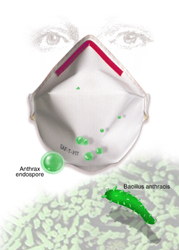
A particulate respirator mask can easily filter out Anthrax endospores. (illustration by Dominic Doyle)
Bioterrorism: Protecting yourself and your patient
Biological agents are classified into three major categories: bacteria, viruses, and toxins. There are various ways to disseminate (spread) the agent. A few examples include: aerosol dispersion to produce an airborne hazard; oral dissemination via contamination of food, water or medicine; dermal exposure by direct contact or injection.
Medical personnel need to understand how these agents can be spread and the risk associated with each.
Following is a list of some potential agents, the risk of coming into contact and of contracting the disease if you are caring for a patient who has been infected, and the means of protection for each.
Anthrax (bacteria)
Risk: Low—can be exposed by inhalation, ingestion or direct contact. Particles are normally too large to be dispersed by aerosol spray unless they have been “weaponized.” Anthrax is not contagious from person to person.
Protection: Standard universal precautions should be taken when treating patients exposed to anthrax. If the material is still on the person, decontaminate immediately. Standard gloves, gown and mask will provide necessary protection. Instruments should be thoroughly cleaned with a strong sporicidal agent.
Plague (bacteria)
Risk: Very low—the greatest danger from the plague is from pneumonic plague because the victim produces an infectious aerosol, which is highly contagious.
Protection: Standard universal precautions should be taken when treating patients exposed to the plague. Heat, disinfectants (2 percent-5 percent hypochlorite) and exposure to sunlight render the bacteria harmless.
Tularemia (bacteria)
Risk: Very low—not considered contagious, but the bacteria can be inhaled, injected or ingested.
Protection: Standard universal precautions should be taken, however person-to-person spread is unusual and respiratory isolation is not required.
Smallpox (virus)
Risk: Low—considered minimum but can be highly infectious through droplets. Smallpox has a 30 percent secondary infection rate, which makes it less communicable than measles or influenza. Any confirmed case of smallpox should be considered an international emergency with immediate report made to public health authorities. Patients are typically infectious from three to six days after onset of fever.
Protection: Droplet and airborne precautions for a minimum of 16-17 days following exposure for all contacts.
Viral Hemorrhagic Fevers (virus)
Risk: Low—although of a highly infectious nature, risk is considered low because evidence for weaponization does not exist for many of these viruses. However, the potential for aerosol weaponization does exist and thus considered a concern.
Protection: Contact precautions for all health care workers, isolation measures and barrier nursing procedures (mask, gown, glove and needle precautions) are indicated. Decontamination is accomplished with hypochlorite or phenoli disinfectants.
Botulinum (toxin)
Risk: Very low—not dermally active and secondary aerosols from patients (coughing) is not a hazard. Typically associated with food outbreaks, it has been used as a weapon.
Protection: Standard universal precautions can be decontaminated with soap and water.
Ricin (toxin)
Risk: Very low—ricin is derived from the beans of the castor plant and due to its ubiquitous worldwide growth, this toxin is potentially widely available. It has several routes of exposure (aerosol, ingestion, injection), however large amounts would be necessary for use as a weapon of mass destruction. Ricin cannot be spread person to person.
Protection: Standard universal precautions, can be decontaminated with soap and water from skin surfaces.













